
The state of Virginia is located on the southeastern coast of the United States and features a diverse terrain that includes mountains, coastal plains, and beaches. This wide range of habitats makes it perfect for countless species of wildlife to thrive and prosper. However, Virginia is also home to some species of animals that have been classified as endangered. Habitat loss due to urbanization is the leading cause of this endangerment for many species. Without animal conservation efforts and repopulation, it is unlikely that their populations will increase to their historical numbers. Below we will take an in-depth at nine endangered animals in Virginia.
Hawksbill Sea Turtle (Eretmochelys imbricata)
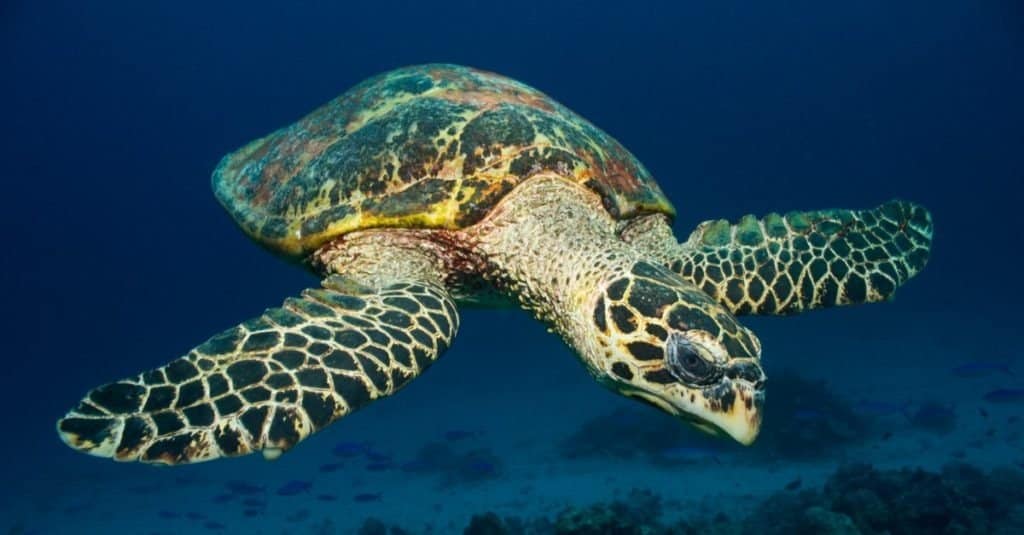
As its name implies, the hawksbill
sea turtle
has a curved hawk-like beak.
©John Back/Shutterstock.com
The hawksbill turtle belongs to the Cheloniidae family and lives in Virginia’s coastal waters. It is a medium-sized turtle with a shell size between 2 to 3 feet in length. These animals can even weigh up to 150 pounds! They have distinctive pointed beaks, and their shells feature elaborate overlapping brown, yellow, and black patterns.
As its name implies, the hawksbill sea turtle has a curved hawk-like beak. They use their beak to graze on sea sponges, algae, and other small invertebrates. They also eat the occasional jellyfish, small fish, or unlucky crustacean. These turtles are a vital part of the ocean’s ecosystem as they control the population of sea sponges, which compete with coral for space and resources. Without these turtles, the overall health of reefs could decline.
This species is migratory and travels huge distances across the ocean. An interesting fact about the hawksbill sea turtle is that during the nesting season, the females will crawl out of the water and onto the beach to lay their eggs in the sand. Their eggs will hatch around 60 days later, and the young will traverse the sandy beach back to the ocean while avoiding predators.
The U.S. Fish and Wildlife Service manages the conservation efforts for the hawksbill sea turtle. Efforts include researching the turtles’ behavior and numbers, designating critical habitat areas to help them thrive, and monitoring fishing practices to prevent bycatch of the turtles.
Virginia Big-Eared Bat (Corynorhinus townsendii virginianus)

The Virginia big-eared bat lives in caves throughout the entire year and only leaves to hunt for food.
©Larisa Bishop-Boros / CC BY-SA 3.0 – License
The Virginia big-eared bat resides in Virginia, West Virginia, North Carolina, and Kentucky. It is an endangered species, and conservationists estimate there are less than 20,000 of these bats left. The Virginia big-eared bat has light to dark brown fur that is long and soft. They are cave-dwelling bats that weigh between 0.3 and 0.5 ounces. Adults are generally between 3.75 and 4.25 inches in length. The bat gets its name from its distinguishable big ears that are around 1.25 inches in length. That’s more than one-quarter of their entire body length!
The Virginia big-eared bat lives in caves throughout the entire year and only leaves to hunt for food. They are nocturnal and use their sonar for hunting at night. As insectivores, their diet consists of insects such as moths, beetles, flies, bees, and wasps.
This endangered species’ primary threat is loss and degradation of their cave habitats and summer roosts. The Virginia big-eared bats play important roles in the ecosystem by controlling insect populations. Conservation efforts include protecting their habitat, preventing human disturbance, and preventing damage to habitats. In 1976, the estimated population of these bats was around 3,000 individuals. There was a 77% increase in population recorded in 2009 since the original report in 1983. This was a huge success and the Endangered Species Act made it possible.
Rusty Patched Bumblebee (Bombus affinis)

These bumblebees have a characteristic rusty patch on the middle of their backs and black bodies with yellow markings.
©Taxomony/Shutterstock.com
Rusty-patched bumblebees are a relatively large species of bee, with normal workers ranging in size from between 0.3 to 0.6 inches long. They have a characteristic rusty patch on the middle of their backs and black bodies with yellow markings.
These bumblebees are social insects and live in colonies with a large number of workers and a single queen bee. They travel from flower to flower of many different plants collecting nectar and pollinating. The main plants they tend to visit are wildflowers, fruit trees, and vegetable crops. They are very important pollinators for these plants. Like other bumblebees, rusty patched bumblebees maintain their body temperature by congregating together and vibrating, creating warmth.
The decline of the rusty patched bumblebee in Virginia happened rapidly. Conservationists declared the species endangered in 2017. The exact reason for their population loss is unknown. However, it may be due to exposure to insecticides and habitat loss. Conservation efforts of these crucial bumblebees by the U.S. Fish and Wildlife Service include actively monitoring the species, habitat management and enhancement, and careful planning and research of the bumblebee.
Red-Cockaded Woodpecker (Picoides borealis)
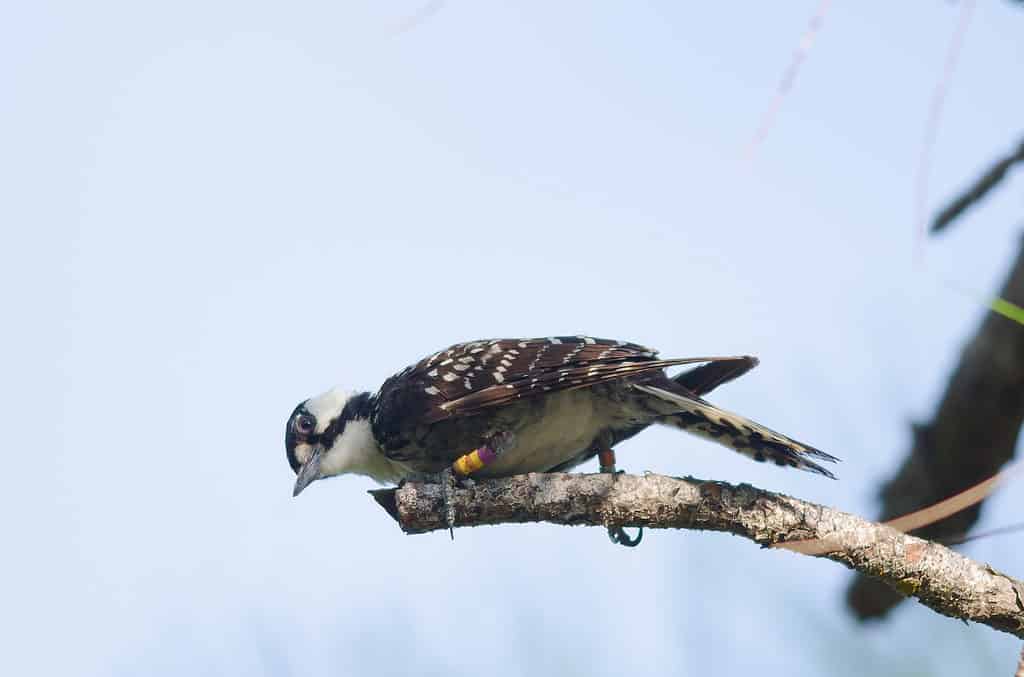
The distinguishing features of the red-cockaded
woodpecker
are its black cap and nape with large white cheek patches.
©iStock.com/spates
The red-cockaded woodpecker is endemic to the Southeastern United States. It is a small species, only around 7.9 to 9.1 inches in length, and weighing 1.4 to 2 ounces. These birds are endangered, with an estimated 12,500 birds left overall. These birds are locally extinct in some states, such as Kentucky and New Jersey. The distinguishing features of the red-cockaded woodpecker are its black cap and nape with large white cheek patches. The woodpecker gets its name from the males that have a small red streak on each side of their black cap. This red streak, called a cockade, is usually displays during the breeding season or in territorial defense.
The red-cockaded woodpecker’s diet mainly consists of ants, beetles, cockroaches, caterpillars, spiders, and fruits. Predators such as rat snakes, eastern screech owls, and hawks eat these woodpeckers as prey. The red-cockaded woodpecker is the only species of woodpecker that excavates its nesting and roosting cavities in living pine trees.
The primary threat to these birds is habitat loss and logging. Conservation efforts strive to recover the species, with one critical conservation strategy being habitat management. Protecting mature pine forests and planting longleaf pine are just a couple of ways we can help the red-cockaded woodpecker. The population of these birds has increased due to the massive conservation efforts implemented.
Canebrake Rattlesnake (Crotalus horridus)

These rattlesnakes have patterns of dark diamond-shaped blotches along their backs that are outlined with lighter scales.
©Scott Delony/Shutterstock.com
The canebrake rattlesnake is a large and venomous snake that is around 4 feet in length but can grow up to 6 feet. Their average weight is around 5 pounds, but they can get up to 10 pounds in some instances. They have patterns of dark diamond-shaped blotches along their backs that are outlined with lighter scales. They have black tails with a distinctive rattle, which they use to warn predators and threats.
These snakes are usually not aggressive towards humans but will defend themselves if they feel threatened. To catch their prey, they will lie in wait until an unsuspecting critter comes within striking range. They will then launch at lightning speeds to secure their meal. Their diet includes mice, rats, birds, and other reptiles.
State laws and regulations in Virginia protect the canebrake rattlesnake. There are regulations in place on the collection and possession of the animal as well. The conservation efforts of these snakes include habitat protection and management, researching the population size and distribution, and public education regarding the status and behavior of the canebrake rattlesnake.
American Water Shrew (Sorex palustris)
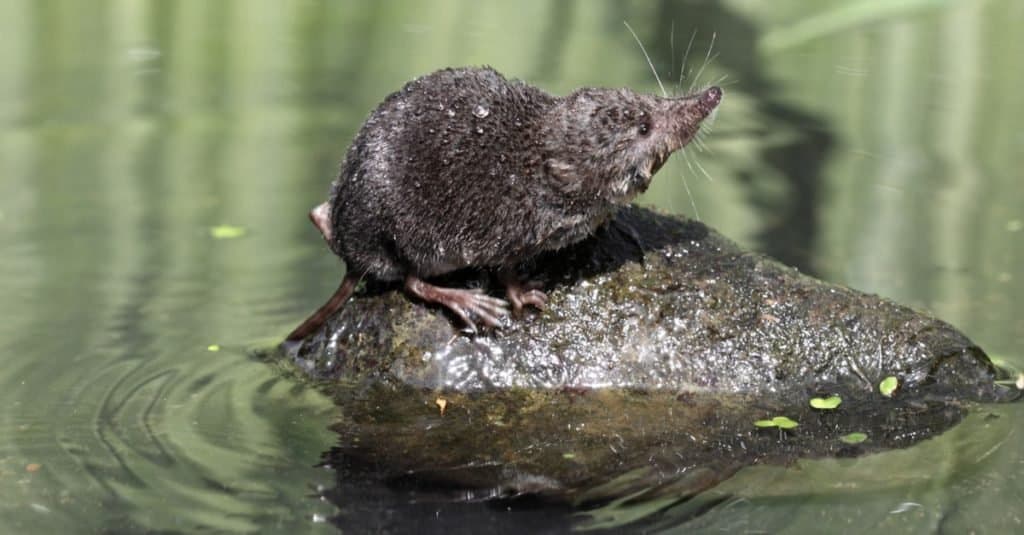
Similar to the Eurasian water shrew, pictured above, the American water shrew is black or brown with water repellant fur.
©Erni/Shutterstock.com
The American water shrew is a rodent living throughout the mountain ranges of the Northern United States, Canada, and Alaska. Their habitats are generally semi-aquatic. Interestingly, these creatures are the smallest mammalian divers. The American water shrew is around 5.1 to 6.7 inches in length and weighs between 0.28 and 0.63 ounces. They are generally black and brown with water-repellant fur.
The American water shrew generally targets aquatic prey and is mainly a nocturnal hunter. This means that they do not use their eyes to locate their prey underwater. Instead, scientists believe they use their whiskers to detect movement or sniff underwater! The predators of the American water shrew include trout, bass, and weasels.
This endangered species is subject to habitat loss due to water pollution. No conservation plans have been made for this species. However, the Game and Wildlife Code protects the American water shrew. Habitat protection and controlling water pollution are some of the ways to protect this population.
Snowshoe Hare (Lepus americanus)
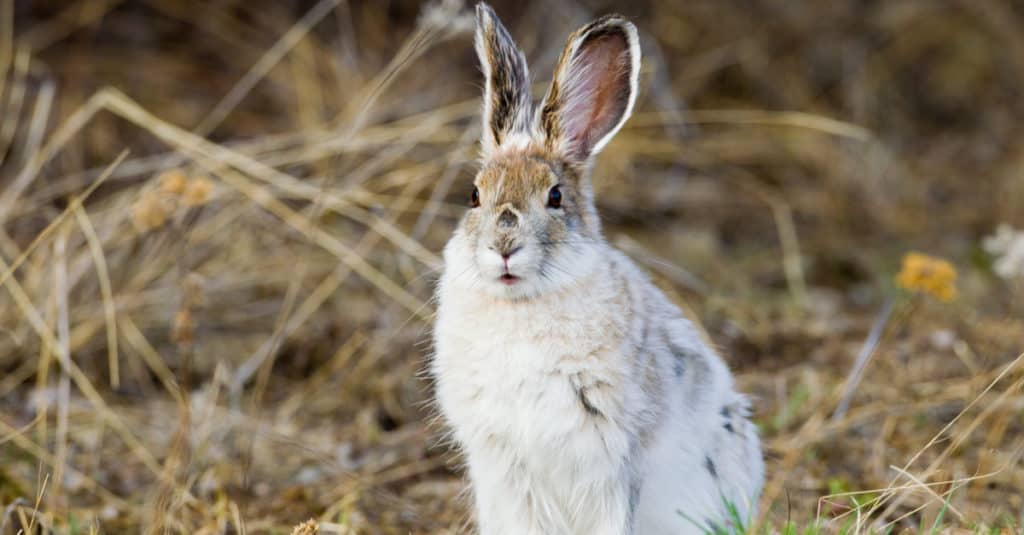
The
snowshoe hare
‘s fur turns white during the winter and brown during the summer.
©Jukka Jantunen/Shutterstock.com
The snowshoe hare resides in various parts of North America. The name comes from the species’ large hind feet. This feature prevents their feet from sinking into the snow when they hop and walk. The snowshoe hare‘s fur turns white during the winter and brown during the summer. This hare also has distinguishable black tufts of fur on the edge of its ears. Their ears are also noticeably shorter than the ears of other hares. These cute animals are around 16.3 to 20.4 inches in length and weigh between 3.15 and 3.42 lbs.
Their diet in the summer mainly consists of plants like grass, ferns, and leaves. In the winter, they eat twigs, bark, and pines. Being a small animal, snowshoe hare has several predators, with the major one being the Canada lynx.
These adorable animals used to exist throughout the mountainous regions of Western Virginia. Now, these animals are only present in isolated areas and are endangered in Virginia. Logging activities and the burning of forests have resulted in decreased populations. In addition, because these creatures rely on snowfall for survival in winter, global warming has also had devastating effects on the snowshoe hares’ range.
Leatherback Sea Turtle (Dermochelys coriacea)
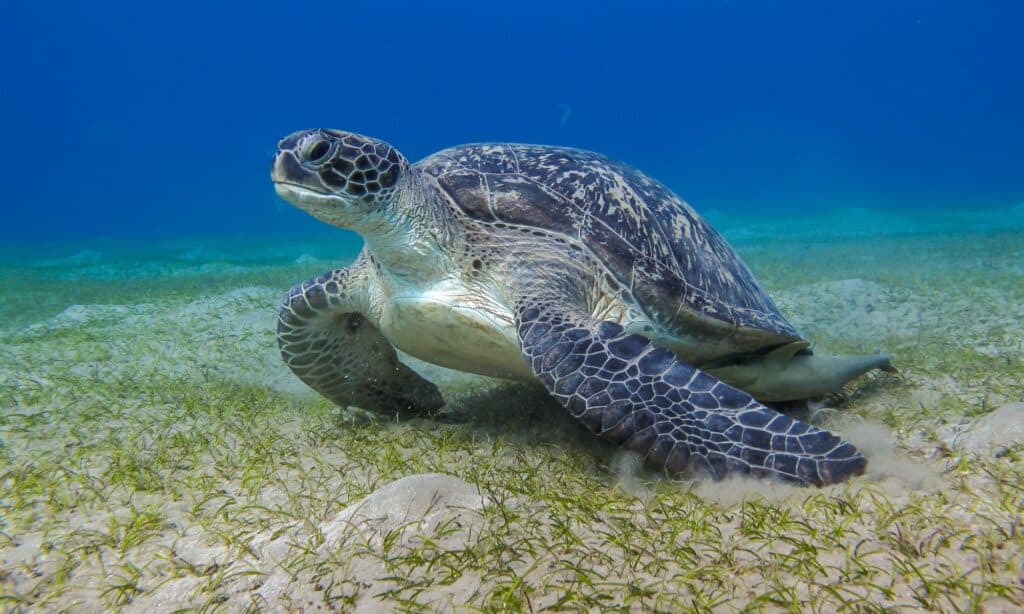
These turtles have a thick leather-like shell which is a dark black color.
©iStock.com/YasserBadr_Beenthere
The leatherback sea turtles are the largest of all sea turtles and typically measure around 6 feet in length and weigh between 500 to 1,500 pounds. Unlike other species of sea turtle, the leatherback does not have a hard and bony shell. Instead, these turtles have a thick leather-like shell which is a dark black color. Their skin is also black with a pinkish-white underside. They have long and pointy beaks which they use to easily catch their prey.
The leatherback sea turtles’ main diet consists of jellyfish and other invertebrates, which class them as gelatinivores. They also eat squid, small fish, crustaceans, and algae on occasion.
These turtles are the third most common turtle living in Virginia’s waters. Unfortunately, six to 10 are stranded in Chesapeake Bay each year. The Virginia Aquarium and Marine Science Center is invested in conserving these giant sea creatures. Their efforts include monitoring populations, rehabilitating sick and injured turtles, and educating the public about their endangered status.
Unfortunately, in recent decades, the population of leatherback sea turtles has been declining rapidly. Western Pacific leatherback numbers have fallen by 80 percent, and Eastern Pacific numbers have fallen by a staggering 97 percent. Some estimate there are only 35,000 nesting females worldwide.
Spruce-Fir Moss Spider (Microhexura montivaga)

Their preferred habitat is damp but well-drained moss in well-shaded areas.
The spruce-fir moss spider lives at high elevations in the Southern Appalachian Mountains. It is a small spider that measures only around ⅛ inch. This species’ coloration varies from light brown to dark brown, and it does not have any distinguishing markings. The spider gets its name from its habit of making a home in the moss that grows underneath forest canopies. The forests are usually high-elevation Fraser fir and spruce-fir forests.
The spruce-fir moss spider is an active predator that eats mites and springtails. They construct webs primarily for shelter rather than catching prey. Their preferred habitat is damp but well-drained moss in well-shaded areas.
The population of the spruce-fir moss spider has largely been affected because of the decimation of high-elevation spruce-fir forests by logging and wildfires. Recently, the forests have been negatively affected by balsam wooly adelgid (an exotic insect) and air pollution. The conservation efforts for this spider include a dedicated Southern Appalachian Spruce Restoration Initiative program, which is a multi-organization partnership that aims to expand the red spruce forests which the spruce-fir moss spider inhabits.
Summary Of 9 Amazing Animals That Are Endangered And Living In Virginia
| Rank | Animal |
|---|---|
| 1 | Hawksbill Sea Turtle |
| 2 | Virginia Big-Eared Bat |
| 3 | Rusty Patched Bumblebee |
| 4 | Red-Cockaded Woodpecker |
| 5 | Canebrake Rattlesnake |
| 6 | American Water Shrew |
| 7 | Snowshoe Hare |
| 8 | Leatherback Sea Turtle |
| 9 | Spruce-Fir Moss Spider |
The photo featured at the top of this post is © FotoRequest/Shutterstock.com
Thank you for reading! Have some feedback for us? Contact the AZ Animals editorial team.






